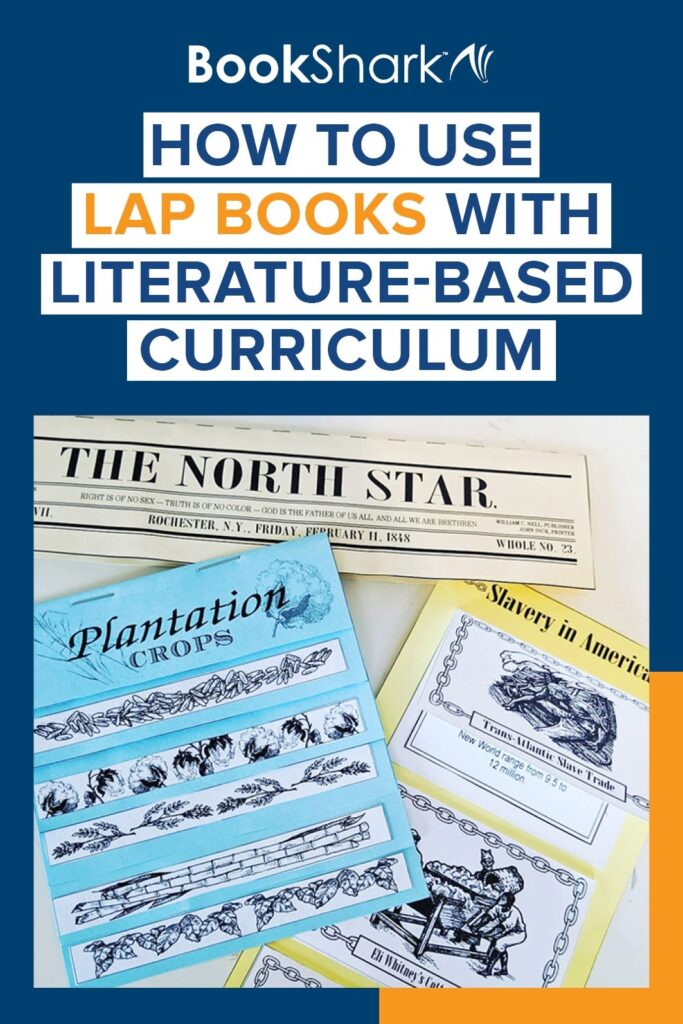




How to Use Lap Books with Literature-based Curriculum

Visual aids work. It’s the reason companies spend thousands of dollars on an icon to represent their brand. The same principle works for us homeschool moms. When we can connect homeschool lessons to an interactive, visual learning aid, children will understand and remember more readily. If your children are crafty and enjoy cutting, coloring, writing, and assembling papercrafts, lap books are a fabulous way to add a visual and hands-on component to whatever curriculum you use.
A lap book is an interactive notebook with smaller mini books affixed onto a file folder. It’s a fun way for craft-loving kids to organize what they learn.
- The creation of the lap book is part of the learning.
- And then the reviewing of the lap book cements the learning for long-term retention.
Benefits of Lap Books with a Literature-based Approach
Kids get more screen time now than ever before. While digital content has a place, it shouldn’t replace a child’s artwork, handiwork, and creativity. Lap books encourage a child’s natural desire to research, organize, and display the information they learned. What they create becomes a book of information they can reference later and be proud of.
I’m always looking for ways to simplify what we’re learning and to make my teaching time count. Lap books do that for my kids! Although some families think that the time it takes to do lap books can be a turn off, I view them as a long-term investment. Almost ten years later, my sons still take out their lap books and review what they compiled when younger. And I can’t count how many times they reviewed the information through the years while explaining their current topic of interest to family and friends.
Do you have to create lap books to learn? Of course not! Many children (and moms) are content to read and discuss—the cornerstone of the literature-based approach of BookShark curriculum. But if enjoy lap books, then they are one more tool in your toolbelt for narration and composition.
A lap book is also a portfolio of a child’s schoolwork. If you live in an area that requires annual documentation of learning, lap books are tangible and impressive proof of what your child has studied.
After realizing that my sons didn’t have to use glitter or pompoms when making a lap book, we adjusted each lap book to suit each child’s learning style. It has been one of the most flexible tools I’ve ever used with a literature-based approach. If your kids are extra crafty, they can go all out with decorations. But if your children are less interested in embellishments and design, they can keep their work simpler. It’s up to you!

Making foldable projects can help your child master things that require repetition or topics your child is struggling with. For example, if your child can’t remember the helping verbs, then encourage him to create a flip book that lists the words. Creating the book is a learning experience in itself. And then when your child lifts the flaps to recall the word list, the activity becomes active learning. Although you want your child to add tidbits of information which delight him, think of the lap book as a memory aid or reference tool to help your child recall information, too.
Lap Books: Worthless or Worth Keeping?
Mini books, graphs, charts, worksheets, maps, and writing can all be arranged in a lap book. This versatile learning tool can be adapted to each child’s needs, likes, and dislikes, and creative spunk. All you need are basic school supplies, you already have on hand:
- file folders
- glue stick or rubber cement
- paper in various colors
- scissors
- tape
- markers and colored pencils
Then, look at your homeschool science or history lessons with an eye to dividing up chunks of information into small units that can be individual mini books or projects.
- Is there a list? It will probably make a good lap book project maybe as cards or a flipbook.
- Cause and effect? Another lap book project!
- Vocabulary words? Yes, those too make for great lap book components.
- Events in a series? Display them in a small timeline format.
- Diagrams? Perfect for lap books!
Remember that a lap book doesn’t have to include everything you studied from a chapter or topic. Pick and choose the parts that your child finds captivating and wants to illustrate through papercrafts. Lap booking works perfectly in the narration stage of your homeschool lesson. After your Read-Alouds, ask your children to narrate back what they learned, using the discussion questions in your Instructor’s Guide. Then make a project for your lap book based on what your child narrated.

You may want to create one or two minibooks a day depending on their complexity. A very elaborate project may stretch out over several days. Store each project in a ziploc bag as your child creates them. After your child finishes 10 to 13 minibooks, he can arrange them on a file folder base.
Tips for Using Lap Books with Your Homeschool Curriculum
Here are a few dos and don’ts to avoid lap book pitfalls.
- Do cut some of the mini books for your child and fold some of the completed worksheets for him. Look at this tutorial for turning boring worksheets into interactive minibooks.
- Don’t turn designing the mini books into a crafting session unless the child wants to. The emphasis is on the concepts learned and how they are organized not on the fancy coloring or cutting technique—again, unless your child thrives on that kind of crafty work.
- Do remember that it takes time to build a lap book. So be patient.
- Don’t try to cram every idea or teaching point into the lap book. Pick and choose.
- Do remember that lap books are not only for young children. Lap books give older children a chance to organize the material they’re learning. And extra flaps can easily be added to lap books to accommodate compositions and drawings added by an older learner.
- Do integrate cleanup time into your homeschool day so you aren’t left with that chore by yourself.
While anything you study for homeschool can easily be made into a lap book, many families love buying pre-designed lap book kits, like these for American History I, American History II, World History I, and World History II that provide the exact templates and directions for assembling them. If your children are extremely outside-the-box thinkers, you can use a kit as a springboard for their own designs. Just add additional flaps to the lap book base and add as many extras as you like!
Whether you are looking for a way to reinforce the major teaching points in your literature-based curriculum or are looking for a creative outlet for your budding artist-scholar, lap books are a method to try.

About the Author
Tina Robertson celebrated the graduation of Mr. Senior in 2013 and Mr. Awesome in 2015. Because of her love for new homeschoolers, she mentors moms through her unique program called New Bee Homeschoolers. She loves all homeschoolers, though, as she shares her free 7 Step Curriculum Planner, unit studies, lap books and homeschooling how tos. She can’t sing, dance, or craft, but she counts organizing as a hobby. She is still in the homeschool trenches blogging at Tina’s Dynamic Homeschool Plus.